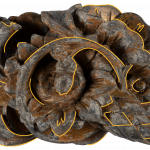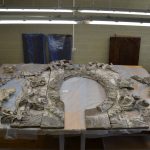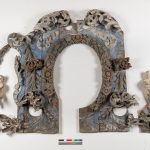Egle Mikko
- Faculty of Art and Culture
- Cultural Heritage and Conservation
- ma
- Research and Conservation of an early 18th century polychromed altarpiece, belonging to the Estonian National Museums collection.
- Tutor(s): Hilkka Hiiop, Tiina-Mall Kreem, Reet Pius

This polychromed altarpiece, with floral and figural carvings, belongs to the Estonian National Museums (ENM) collection and was brought to ENM in 1939, turning the resettlement (Umsiedlung) of Estonian Baltic Germans to Germany. The function and origin of this piece continues to be unexplored, for there aren’t any known sources of its origin prior to ENM. The only source of information regarding this object was drawn up by ENM’s former art historian Helmi Üprus (1911–1978) in 1939, after which the object remained unaroused in the museums’ vast collection until 2016, when the ENM moved to the new building at Raadi (Museum street 2). In the summer of 2017 Christian Ackermann’s research team was called to assess this object, associated with Ackermann’s name, by ENM’s conservator Mariliis Vaks. After the research team’s analysis of the object, a conclusion was drawn, that figural carvings belonging to the
object’s composition lack similar traits to Christian Ackermann’s figure carving style, which put the former attribution (made by Helmi Üprus) under question. This analysis gave cause to further clarify and research the sculptor / author behind the object in this thesis. The altarpiece intrigues with an abundance of research questions, regarding its former function as an ecclesiastical piece, its iconographical subject matter and by its aforementioned unestablished sculptor’s workshop. Before anything else this thesis focuses on resolving the objects conservation problems and conducting practical conservation works. The main conservation problem resides in the badly damaged polychrome layers, which have lifted and flaked off from the wooden support and original ground layers. The objects polychromies’ consists of a lower, originally colourful baroque paint layer, which has been later concealed under a thick layer of white overpaint. The overpainting is in large parts detached from the original layer, causing extensive losses to both. Therefore, the aim of conservation treatment is to stop further decaying and losses to the paint layers, by establishing a treatment decision, which was formulated using value and ideal state analysis defined by author Barbara Appalbaum and a decision-making diagram designed by ENM’s conservator Mariliis
Vaks. The objective of this analysis was to decide whether to remove the later overpaint layer, and reveal the original vivid polychrome layer, or conserve both the overpaint and the original paint layers.
Before any conservation treatment decisions could be made, an extensive study of the object was made, to form hypotheses regarding its: past, function, description, polychromies and sculptors’ workshop. This research forms the first two chapters of the thesis. The first chapter gives an overview of information known of the objects’ past, where it came from and by whom it was sent to the ENM. Followed by a detailed description of the altarpiece’s carvings, wood carving and carpentry techniques. In this part a dendrochronological analysis was also conducted (by Dr Alar Läänelaid) of the altarpiece’s pinewood boards. Which concluded, that the object was made somewhere between 1700–1710, dating the piece to the early 18th century. The objects former
function was concluded in the analysis to have either been an epitaph or a part of a multi-story epitaph retable. As part of the research, the subject of the altarpieces lost oval painting was also explored. The former painting most likely depicted the Christs crucifixion scene, painted on a wooden panel. Technical analyses (by Dr Signe Vahur and Dr Ragnar Sage) of the objects’ polychrome layers confirmed, that the objects original layer was painted in a multitude of techniques: the figures were painted in flesh tones, acanthus ornaments in blue-white marble imitation and floral carvings were painted with gleaming brass leaf gilding overlaid with green, red or bluish-black translucent colour glazes (lüsterfassung). The later white overpainting layer was
considered to be from the 19th century, based on the paint layers technical analyses.
The second chapter explores the styles and works of most notable sculptors who worked in Estonia between 1700–1710 (Christian Ackermann, Jakob Leu, Dietrich Neuhausen, Dietrich Walther, Joachim Armbrust), to identify the sculptor of the ENM altarpiece. This investigation reaches a conclusion that the object was made by a baroque era sculptor – Joachim Armbrust.
Based on the conclusions made in the first two chapters, an assessment of the objects’ values and preferred ideal state was made, with a treatment goal to remove the later overpaint layer and reveal the original multicoloured polychrome layer. The last chapters of this thesis give an overview of the conservation treatments used to uncover the well-preserved original paint layer. To remove the white overpainting a combination of dry-, mechanical-, and wet-treatment was used. The lifted and loose original paint layers were placed back to the ground layers and wooden support using an aqueous dispersion of an acrylic copolymer Lascaux 4176, Medium for Consolidation. This acrylic copolymer was also tested and used as a protective coating for the original polychrome layer. After the conservation treatment the altarpieces polychrome layers are stabilized, the finished work can now be reconstructed using wooden structures after which the object will be put on exhibition in the Estonian National Museum.


